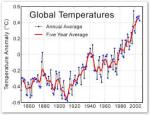I knew it would happen sooner or later. Since global warming is being blamed for just about everything that has taken place in the last few years, it was just a matter of time until it would become the deus ex machina for explaining crime. And since we’re talking about global warming, the news can’t be very good. In fact, Matthew Ranson, the young scholar who has produced this research, is confident that by the end of this century, the general increase in temperatures will produce an additional 22,000 murders and millions of other additional violent crimes. He bases this prediction on what he refers to as the “causal relationship between weather and crime,” data for which he has studied covering the last thirty years.
 According to Ransom, there is a correlation between higher temperature and more crime due to what he calls the “social interactions” that produce crime, many of which tend to increase as temperatures become warmer. These interactions include such things as more people being outside when weather gets warm, and a greater degree of intolerance towards various social stress-points when hot weather leads to feelings of physical discomfort which then leads to more aggression which results in more crime.
According to Ransom, there is a correlation between higher temperature and more crime due to what he calls the “social interactions” that produce crime, many of which tend to increase as temperatures become warmer. These interactions include such things as more people being outside when weather gets warm, and a greater degree of intolerance towards various social stress-points when hot weather leads to feelings of physical discomfort which then leads to more aggression which results in more crime.
Using crime data from the FBI’s Uniform Crime Reports, Ransom is able to neatly correlate crime rates with mean annual temperatures throughout the United States. He identifies 4 temperature zones basically running East-West from the northern border where the mean annual temperature is less than 55 degrees, to the extreme southern part of the country where the mean is above 75 degrees, and two other belts of 55-64 and 65-74 degrees in between. Turns out that the rates for such common crimes as burglary, larceny and assault were all roughly 20% higher in the warmest as opposed to the coolest parts of the country, and that in all four zones the monthly rate for these crimes increased substantially during the warmest months of the year. Using the change in crime rates relative to increases in temperature, Ransom is able to predict what would happen to crime trends if mean temperatures move upwards over the next 85 years.
I’m not going to get into a detailed analysis of Ransom’s statistical methods which are quite impressive and take into account some of the discrepancies and inaccuracies of the information which often escapes discussion when scholars use crime data from the UCR. But I do find it interesting that Ransom would base this entire paper on an assumption about the causality of crime which, it seems to me, discounts or ignores other factors that need to be addressed. It just so happens that in many locations where he finds correlations between higher crime rates and higher temperatures, one could also make many other correlations, in particular having to do with demographics and socio-economic circumstances of the populations that live in those zones. Despite Ransom’s assertion that criminals operate most frequently at times and places where they can escape detection following commission of the crime, summer months also yield much greater periods of daylight which, in turn, is often correlated with higher rates of crime.
Ransom uses data covering the last 30 years to make predictions about a period ahead of us that’s three times as long. But I would have felt a little more accepting of his method had he acknowledged the fact that during the period covered by his data it appears that mean temperatures increased and yet serious crime in every category underwent a significant decline. On the other hand, it will be interesting to see how the pro-gun partisans in the gun debate react to Ransom’s work. Because most of the noise supporting the 2nd Amendment comes from groups that just as vociferously deny the threat of global warming at all. But if Ransom is correct and global warming will result in millions of additional serious crimes, shouldn’t the NRA align itself with the global warming crowd and use their argument to promote the right of law-abiding citizens to carry guns and protect themselves against crime?
Leave a Reply